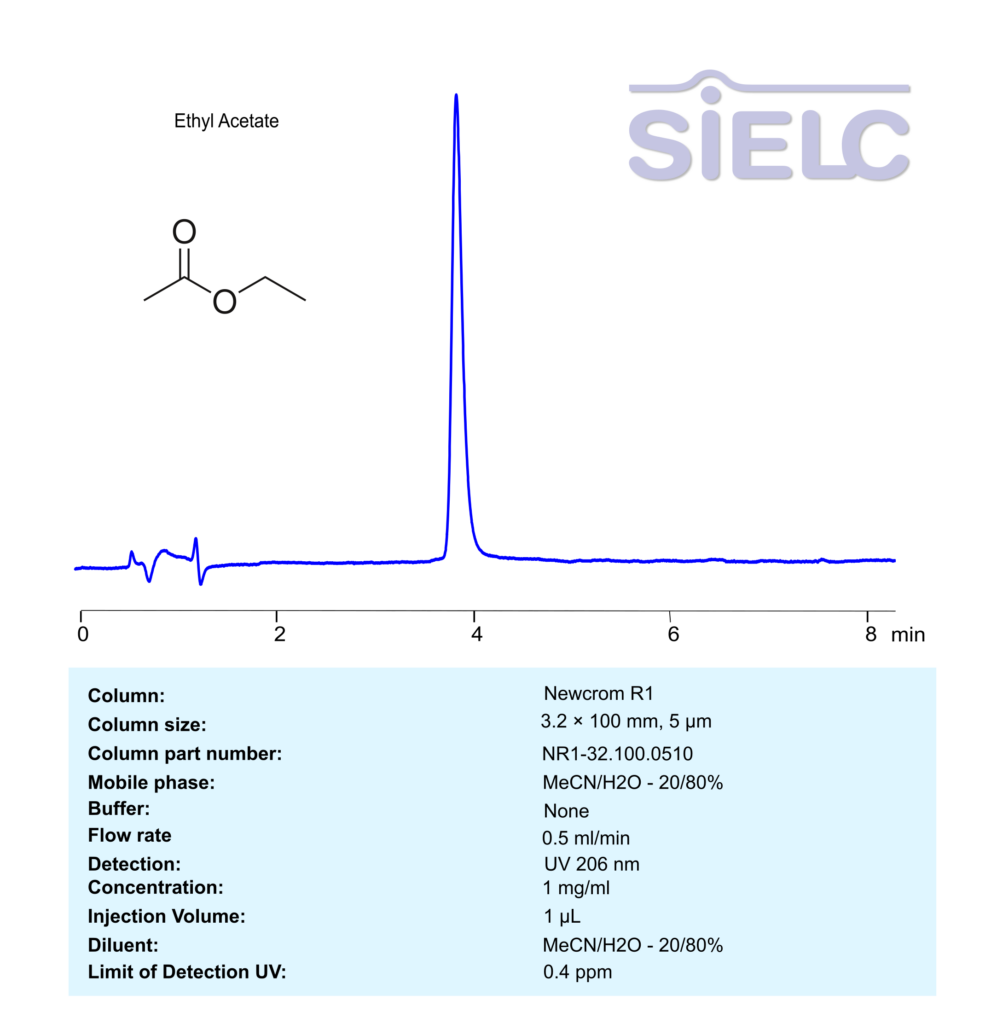| CAS Number | 141-78-6 |
|---|---|
| Molecular Formula | C4H8O2 |
| Molecular Weight | 88.107 |
| InChI Key | XEKOWRVHYACXOJ-UHFFFAOYSA-N |
| LogP | 0.73 |
| Synonyms |
|
Applications:
UV-Vis Spectrum of Ethyl Acetate
September 9, 2024
For optimal results in HPLC analysis, it is recommended to measure absorbance at a wavelength that matches the absorption maximum of the compound(s) being analyzed. The UV spectrum shown can assist in selecting an appropriate wavelength for your analysis. Please note that certain mobile phases and buffers may block wavelengths below 230 nm, rendering absorbance measurement at these wavelengths ineffective. If detection below 230 nm is required, it is recommended to use acetonitrile and water as low UV-transparent mobile phases, with phosphoric acid and its salts, sulfuric acid, and TFA as buffers.
For some compounds, the UV-Vis Spectrum is affected by the pH of the mobile phase. The spectra presented here are measured with an acidic mobile phase that has a pH of 3 or lower.

HPLC Method for Analysis of Ethyl Acetate on Newcrom R1 Column
September 9, 2024
High Performance Liquid Chromatography (HPLC) MS Method for Analysis of Ethyl acetate on Newcrom R1 by SIELC Technologies
Separation type:Liquid Chromatography Reverse Phase SIELC Technologies

High Performance Liquid Chromatography (HPLC) Method for Analysis of Ethyl acetate
Ethyl acetate (C₄H₈O₂) is a chemical compound classified as an ester. It is produced by the reaction of ethanol and acetic acid (known as esterification). Ethyl acetate is commonly used as a solvent in various applications such as chromatography, paints, coatings, adhesives, and in the production of synthetic fruit essences and flavors.
It is widely utilized in analytical chemistry and extraction processes due to its good solvency for a variety of compounds.
Ethyl acetate can be retained, separated and analyzed using a Newcrom R1 column. The analysis employs an isocratic method with a simple mobile phase comprising water and acetonitrile (MeCN). This method allows for detection using Vis 200 nm.
You can find detailed UV spectra of Ethyl acetate and information about its various lambda maxima by visiting the following link.
| Column | Newcrom R1, 3.2 x 100 mm, 5 µm, 100 A, dual ended |
| Mobile Phase | MeCN/H2O- 20/80% |
| Buffer | None |
| Flow Rate | 0.5 ml/min |
| Detection | UV 206 nm |
| Sample | 1 mg/ml |
| Diluent | MeCN/H2O- 20/80% |
| LOD | 0.4 ppm |
| Class of Compounds | Ester |
| Analyzing Compounds | Ethyl acetate |
Application Column
Newcrom R1
Column Diameter: 3.2 mm
Column Length: 100 mm
Particle Size: 5 µm
Pore Size: 100 A
Column options: dual ended

Separation of Ethyl acetate on Newcrom R1 HPLC column
February 16, 2018
Ethyl acetate can be analyzed by this reverse phase (RP) HPLC method with simple conditions. The mobile phase contains an acetonitrile (MeCN), water, and phosphoric acid. For Mass-Spec (MS) compatible applications the phosphoric acid needs to be replaced with formic acid. Smaller 3 µm particles columns available for fast UPLC applications. This liquid chromatography method is scalable and can be used for isolation impurities in preparative separation. It also suitable for pharmacokinetics.
Application Column
Newcrom R1
The Newcrom columns are a family of reverse-phase-based columns. Newcrom A, AH, B, and BH are all mixed-mode columns with either positive or negative ion-pairing groups attached to either short (25 Å) or long (100 Å) ligand chains. Newcrom R1 is a special reverse-phase column with low silanol activity.
Select options


